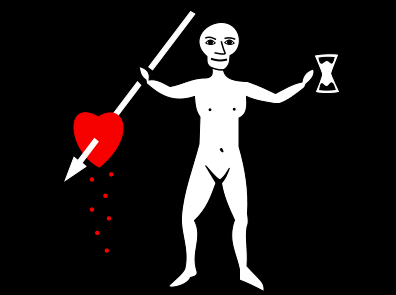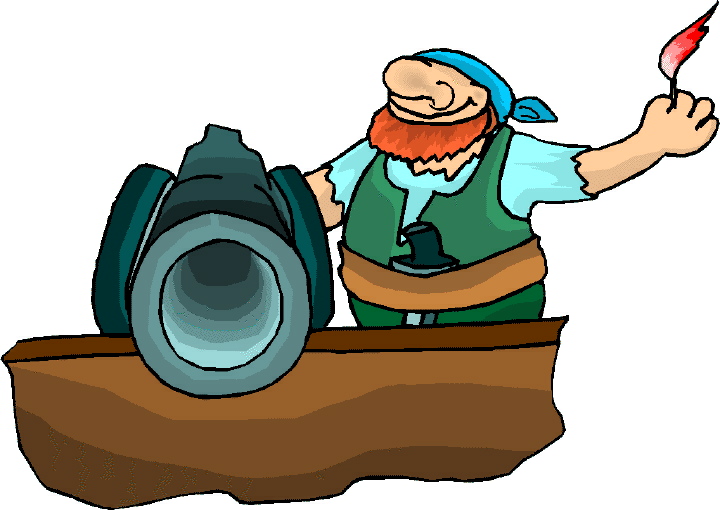 Pirates and Privateers Pirates and Privateers
The History of Maritime
Piracy
Cindy Vallar, Editor
& Reviewer
P.O. Box 425,
Keller, TX 76244-0425
    
The Jolly
Roger and No Quarter Given
by Cindy Vallar
 Skulls
and crossed bones were synonymous with pirate flags,
but the use of such symbols to denote death predated
the appearance of the first Jolly Roger. They were
frequently found on tombstones, and ships’ logs
often contained skulls beside deceased crew members’
names. Once pirates adopted the familiar skull and
crossbones as their emblem, frequently on a field of
black, anyone who saw their flags recognized the
implied threat. To further intimidate their prey,
pirates used other symbols. The swords found on the
flags of Thomas Tew
and Calico Jack
Rackham symbolized power over life.
Christopher Moody added an hourglass with wings to
make his intentions clear: time was swiftly running
out. Dancing skeletons signified that the pirates
cared little for their fate. A raised glass
meant they toasted death. Skulls
and crossed bones were synonymous with pirate flags,
but the use of such symbols to denote death predated
the appearance of the first Jolly Roger. They were
frequently found on tombstones, and ships’ logs
often contained skulls beside deceased crew members’
names. Once pirates adopted the familiar skull and
crossbones as their emblem, frequently on a field of
black, anyone who saw their flags recognized the
implied threat. To further intimidate their prey,
pirates used other symbols. The swords found on the
flags of Thomas Tew
and Calico Jack
Rackham symbolized power over life.
Christopher Moody added an hourglass with wings to
make his intentions clear: time was swiftly running
out. Dancing skeletons signified that the pirates
cared little for their fate. A raised glass
meant they toasted death.
 Why use
such symbols of death and destruction to instill
fear? Pirates earned their wages by capturing prizes
and ransoming captives. To do battle against their
opponent risked the intended cargo and ship they
meant to confiscate. A fight could also mean their
own deaths. Rather than resort to physical violence
(although they did so when necessary), they
preferred to wage psychological
warfare. Woe to any merchantman who dared to
defy the warning, for some pirates gave no quarter. Why use
such symbols of death and destruction to instill
fear? Pirates earned their wages by capturing prizes
and ransoming captives. To do battle against their
opponent risked the intended cargo and ship they
meant to confiscate. A fight could also mean their
own deaths. Rather than resort to physical violence
(although they did so when necessary), they
preferred to wage psychological
warfare. Woe to any merchantman who dared to
defy the warning, for some pirates gave no quarter.
Pirates, navies, and merchantmen used flags to
identify other ships. Most carried an assortment of
ensigns aboard. The ruse de guerre was a
frequent ploy that allowed ships to approach the
enemy before declaring their true intentions. As
they neared their target, the ship flew the national
flag of the ship they approached, signifying
friendship. When the prey was within range,
they hoisted their true colors and caught them off
guard. The first maritime flags were often
solitary-colored banners and came into use during
the Middle Ages. Eventually each nation adopted its
own flag for easier identification and solidarity.
Pirates were no different, for they considered
themselves a nation (albeit one of a criminal
nature). In time, anyone who saw their flag through
a spyglass dreaded the meeting to come. Chinese
pirates adopted different colored flags to identify
each squadron. Zheng Yi, the commander of these
fleets, might have flown a flag with an elaborate
design on a field of gold or yellow. Charles
Vane and Edward
Thache flew the Union Jack from one mast while
flying the Jolly Roger from their mainmast.
 Near the start of the
eighteenth century, the Jolly Roger gained
prominence amongst pirates and captains created
their own designs. Aside from those mentioned
earlier, anyone who spotted a skeleton holding an
hourglass in one hand and a spear or dart in the
other while standing beside a bleeding heart knew
who chased them – Edward
Thache, also known as Blackbeard. Bartholomew
Roberts favored one of two flags: a man and a
skeleton, who held a spear or dart in one hand,
holding either an hourglass or a cup while toasting
death, or an armed man standing on two skulls over
the letters ABH and AMH. The latter warned residents
of Barbados and Martinique that death awaited them,
for these islanders had dared to cross Bartholomew
Roberts. Near the start of the
eighteenth century, the Jolly Roger gained
prominence amongst pirates and captains created
their own designs. Aside from those mentioned
earlier, anyone who spotted a skeleton holding an
hourglass in one hand and a spear or dart in the
other while standing beside a bleeding heart knew
who chased them – Edward
Thache, also known as Blackbeard. Bartholomew
Roberts favored one of two flags: a man and a
skeleton, who held a spear or dart in one hand,
holding either an hourglass or a cup while toasting
death, or an armed man standing on two skulls over
the letters ABH and AMH. The latter warned residents
of Barbados and Martinique that death awaited them,
for these islanders had dared to cross Bartholomew
Roberts.
While Buccaneers
of America (a first-hand account of Alexandre
Exquemelin’s years amongst pirates) makes no
mention of the Jolly Roger or the skull and
crossbones, the flag was mentioned during the trial
of Captain John Quelch
and his pirate crew, who were executed in Boston in
1704.
 |
Three
months later the pirates were off the
coast of Brazil flying as a flag the Old
Roger which was ornamented by an anatomy
with an hourglass in one hand, and a dart
in the heart with three drops of blood
proceeding from it in the other. |
It is one of the earliest
recordings of pirates using the black flag as well
as the use of the term "Old Roger." The Oxford
English Dictionary
first defined Jolly Roger in 1724.
English privateers flew the red jack by order of the
Admiralty in 1694. When the War of
Spanish Succession ended in 1714, many
privateers turned to piracy and some retained the
red flag, for red symbolized blood. No matter how
much seamen dreaded the black pirate standard all
prayed they never encountered the jolie rouge.
This red flag boldly declared the pirates’
intentions. No life would be spared. No quarter
given.
This message was confirmed by Captain Richard
Hawkins in 1724, when pirates overtook his ship:
"they all came on deck and hoisted Jolly Roger. . .
. When they fight under Jolly Roger, they give
quarter, which they do not when they fight under the
red or bloody flag."
How did pirate flags become known as the "Jolly
Roger?" No one knows for certain, but there are
several hypotheses. One is that the name is an
English corruption of the French jolie rouge,
which means "pretty red." Others believe it comes
from English slang used to denote the devil (Old
Roger). Or perhaps it comes from Ali Raja, a Tamil
pirate captain who terrorized the Indian Ocean. No
matter its origin, the intent of the skull and
crossbones was clear – intimidation and fear – and
even today we comprehend its meaning.
Copyright ©2001 Cindy Vallar

Click to contact me
Background image compliments
of Anke's Graphics |

